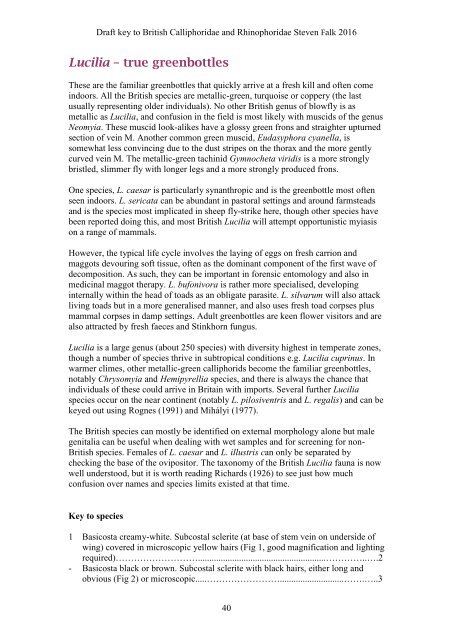BRITISH BLOWFLIES (CALLIPHORIDAE) AND WOODLOUSE FLIES (RHINOPHORIDAE)
4cmTmdCuA
4cmTmdCuA
You also want an ePaper? Increase the reach of your titles
YUMPU automatically turns print PDFs into web optimized ePapers that Google loves.
Draft key to British Calliphoridae and Rhinophoridae Steven Falk 2016<br />
Lucilia – true greenbottles<br />
These are the familiar greenbottles that quickly arrive at a fresh kill and often come<br />
indoors. All the British species are metallic-green, turquoise or coppery (the last<br />
usually representing older individuals). No other British genus of blowfly is as<br />
metallic as Lucilia, and confusion in the field is most likely with muscids of the genus<br />
Neomyia. These muscid look-alikes have a glossy green frons and straighter upturned<br />
section of vein M. Another common green muscid, Eudasyphora cyanella, is<br />
somewhat less convincing due to the dust stripes on the thorax and the more gently<br />
curved vein M. The metallic-green tachinid Gymnocheta viridis is a more strongly<br />
bristled, slimmer fly with longer legs and a more strongly produced frons.<br />
One species, L. caesar is particularly synanthropic and is the greenbottle most often<br />
seen indoors. L. sericata can be abundant in pastoral settings and around farmsteads<br />
and is the species most implicated in sheep fly-strike here, though other species have<br />
been reported doing this, and most British Lucilia will attempt opportunistic myiasis<br />
on a range of mammals.<br />
However, the typical life cycle involves the laying of eggs on fresh carrion and<br />
maggots devouring soft tissue, often as the dominant component of the first wave of<br />
decomposition. As such, they can be important in forensic entomology and also in<br />
medicinal maggot therapy. L. bufonivora is rather more specialised, developing<br />
internally within the head of toads as an obligate parasite. L. silvarum will also attack<br />
living toads but in a more generalised manner, and also uses fresh toad corpses plus<br />
mammal corpses in damp settings. Adult greenbottles are keen flower visitors and are<br />
also attracted by fresh faeces and Stinkhorn fungus.<br />
Lucilia is a large genus (about 250 species) with diversity highest in temperate zones,<br />
though a number of species thrive in subtropical conditions e.g. Lucilia cuprinus. In<br />
warmer climes, other metallic-green calliphorids become the familiar greenbottles,<br />
notably Chrysomyia and Hemipyrellia species, and there is always the chance that<br />
individuals of these could arrive in Britain with imports. Several further Lucilia<br />
species occur on the near continent (notably L. pilosiventris and L. regalis) and can be<br />
keyed out using Rognes (1991) and Mihályi (1977).<br />
The British species can mostly be identified on external morphology alone but male<br />
genitalia can be useful when dealing with wet samples and for screening for non-<br />
British species. Females of L. caesar and L. illustris can only be separated by<br />
checking the base of the ovipositor. The taxonomy of the British Lucilia fauna is now<br />
well understood, but it is worth reading Richards (1926) to see just how much<br />
confusion over names and species limits existed at that time.<br />
Key to species<br />
1 Basicosta creamy-white. Subcostal sclerite (at base of stem vein on underside of<br />
wing) covered in microscopic yellow hairs (Fig 1, good magnification and lighting<br />
required)………………………........................................................…………..….2<br />
- Basicosta black or brown. Subcostal sclerite with black hairs, either long and<br />
obvious (Fig 2) or microscopic.....……………………............................…….…..3<br />
40


